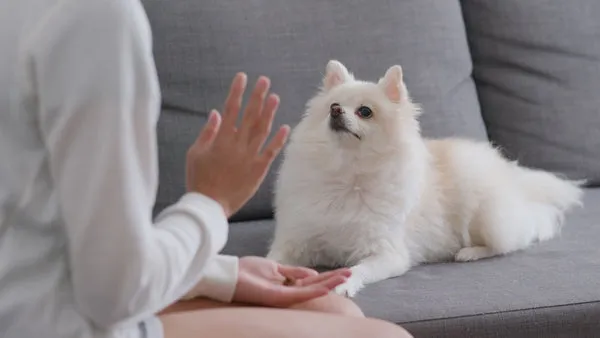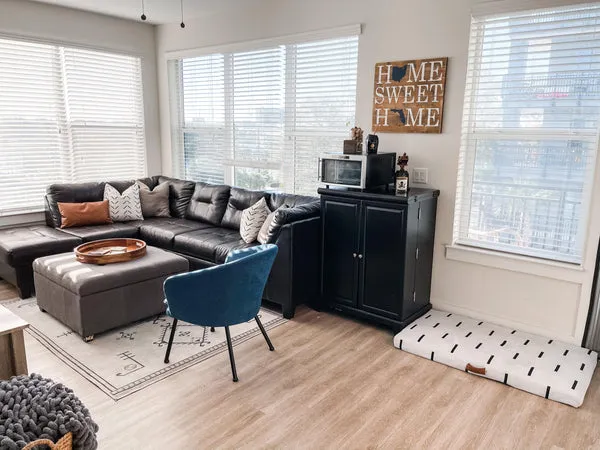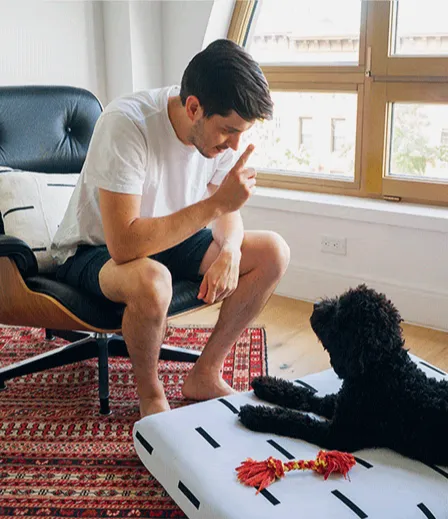For many dog owners, the image of a beloved canine curled up on the sofa is a familiar and comforting one. However, this isn’t always the desired reality, especially when expensive furniture is involved or specific household rules are in place. Deciding on ground rules for couch time is a crucial part of training your dog, whether you have a playful puppy or an older dog with established habits. Luckily, Teaching A Dog To Stay Off Furniture is a reasonably straightforward process that can yield results in as little as 2 to 4 days, depending on your consistency and dedication. This guide will walk you through the most common and effective ways to keep your dog off the couch – for good, if that’s your goal. Mastering this skill contributes to overall good manners and helps in scenarios like how to teach a dog not to jump on furniture.
Effective Methods for Keeping Your Dog Off the Couch
Establishing boundaries early and consistently is key to successful dog training. These methods offer different approaches to help your dog understand and respect furniture limits.
1. The Block Method: Physical Barriers for Success
This method is perhaps one of the easiest and most immediate solutions, as it physically prevents your dog from accessing the forbidden furniture. The concept is simple: if there’s no space for your pup to jump onto, they won’t feel the urge to get on the couch. This is particularly helpful for older dogs who might already have ingrained habits of lounging on the sofa.
You can employ various objects as barriers. Baby gates are a classic choice, effectively blocking access to an entire room or a section of it. Large objects, strategically placed cushions, or even ottomans moved in front of the couch can serve the same purpose. Many stylish décor options are available today that won’t disrupt your home’s aesthetic, such as decorative pet gates or a stack of pillows that can be easily removed when you want to use the couch yourself. This preventive measure helps in teaching your dog boundaries and complements efforts like how to get a dog to stop jumping up on people or furniture.
 Decorative pet gate blocking access to a modern couch
Decorative pet gate blocking access to a modern couch
2. The “Off” and “Up” Command Method: Verbal Cues
While the block method is practical, especially for immediate prevention, it’s not a complete training method on its own. For long-term success and better understanding, focus on teaching your dog specific commands. The “off” command is fundamental for keeping dogs off couch, while the “up” command can be introduced if you wish to allow your dog on the furniture only when invited.
To teach the “off” command, sit in your living room and observe your dog. The moment they hop onto the furniture, approach them with a high-value treat or their favorite toy. Clearly say “off” as you lure them down to the floor. Reward them immediately once all four paws are on the ground. Repeat this process consistently, using the treat as positive reinforcement, until your dog responds reliably to the “off” command without needing a lure.
 Dog being lured off a light-colored couch with a treat, demonstrating the "off" command
Dog being lured off a light-colored couch with a treat, demonstrating the "off" command
Some owners prefer to teach an “up” command, allowing their dogs to join them on the couch occasionally. This teaches your dog that furniture access is by invitation only. For this, you might use a leash for gentle guidance. Excitingly say “up!” while patting the spot where you want them to jump. Use a treat or toy to entice them. If they hesitate, a gentle upward pull on the leash can assist. Praise and reward them generously when they succeed. This dual command approach helps your dog understand boundaries, much like teaching them how to train your dog to stay with you in a specific spot.
 A modern black terrazzo dog bed cover placed neatly on a grey couch
A modern black terrazzo dog bed cover placed neatly on a grey couch
3. The Spot or Place Method: Offering an Alternative
A highly effective strategy for teaching a dog to stay off furniture is to provide an appealing, designated alternative. This involves placing a comfortable dog bed in the same room as your couch and teaching your dog the “place” or “bed” command. Modern dog beds are often designed to complement home décor, making them a seamless addition to your living space.
When your dog approaches the couch, redirect their attention. Say “place” and gently lure them towards their bed with a treat. Initially, you can drop a trail of small treats leading to the bed to reinforce the desired behavior. For more stubborn dogs, a leash can be used to gently guide them to their designated spot. As your dog begins to understand the “place” command, gradually reduce the use of treats. The goal is for them to go to their bed automatically when prompted. Furthermore, start rewarding your dog not just for going to their bed, but for choosing it over the sofa when entering the room. This positive reinforcement solidifies the understanding that the couch is off-limits and their bed is the appropriate resting place, contributing to general good manners like how to prevent dog from jumping on people.
 A small dog relaxing comfortably on a stylish dog bed in a contemporary living room
A small dog relaxing comfortably on a stylish dog bed in a contemporary living room
What to Do When You’re Not Home: Maintaining Consistency
It’s a common scenario: your dog perfectly masters staying off the couch when you’re present, but the moment you leave, they make a beeline for it. Many owners discover this through security cameras, realizing their efforts are undone in their absence. To prevent your dog from jumping on the sofa when you’re away, consistency is paramount.
The easiest and most reliable solution is to block access. This could involve placing a baby gate across the doorway leading to the living room or using deterrents on the couch itself. Another highly effective method is crate training. Crate training can prevent destructive behavior, keep your dog off furniture, and provide a safe den for them when you’re not home. While it requires time and patience, learning how to crate train your dog offers significant benefits for both you and your pup. If crating isn’t an option, consider using deterrents like upside-down plastic mats, aluminum foil, or scent sprays (ensure they are pet-safe) on the furniture to make it unappealing.
Remember, the key to successful dog training, including topics like how to train a stubborn dog to pee outside, is unwavering consistency. Sending mixed signals will only confuse your dog and hinder progress. Ensure everyone in your household is on the same page regarding the rules and training methods for keeping your dog off the couch. Reinforce good behavior diligently.
 A person's hand offering a treat to a dog, reinforcing positive behavior during training
A person's hand offering a treat to a dog, reinforcing positive behavior during training
Successfully teaching a dog to stay off furniture requires patience, consistency, and the right approach. Whether you choose the block method, command training, or providing a comfortable alternative, the goal is to clearly communicate your expectations to your dog. By maintaining a united front with all household members and reinforcing desired behaviors, you can establish clear boundaries that lead to a well-behaved and happy companion. If you’re looking for expert guidance and convenient learning, consider enrolling in professional online dog training programs to further enhance your dog’s training journey.
